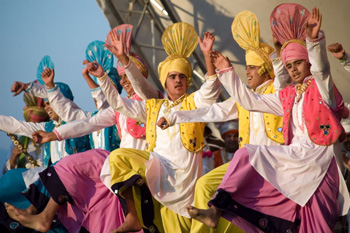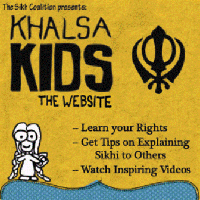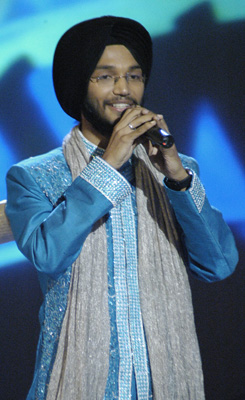
The SJ Mercury News ran a story on Dhol Di Awaz [disclaimer: I went to Cal and was part of the Berk SSA] and made the argument that in today’s multi-generational diaspoa, bhangra is the common thread that holds Punjabis together. I thought this was interesting on many levels. While the article is relatively well-written and sensitive, there were no excerpts from conversations with non-Sikh Punjabis, and certainly not with Pakistani Punjabis.
 This divide over who has a “right” to bhangra has certainly been a source of tension in the DDA-verse in the past — while many embrace bhangra as a Punjabi dance that can be shared by all across religions (and even regions), while others argue that some of the uniform elements of the dance (e.g. the phugri) require a Sikh focus. In the Bay Area, where Punjabis are somewhat divided along religious lines by neighborhoods, are we being truly honest with ourselves re: tolerance and inclusivity? Along those lines, is bhangra tying together generations of Sikh Punjabis from Indian Punjab, or is it tying together ALL Punjabis? I would argue that bhangra (and giddha), which is, in its purest essence, a dance of joy and celebration, belongs to everyone. It doesn’t see religion or region, and it also doesn’t see a “backdated” interpretation of “traditional” uniforms. This made me reflect on a question I often ask myself — where does the Punjabi begin/end and the Sikh begin?
This divide over who has a “right” to bhangra has certainly been a source of tension in the DDA-verse in the past — while many embrace bhangra as a Punjabi dance that can be shared by all across religions (and even regions), while others argue that some of the uniform elements of the dance (e.g. the phugri) require a Sikh focus. In the Bay Area, where Punjabis are somewhat divided along religious lines by neighborhoods, are we being truly honest with ourselves re: tolerance and inclusivity? Along those lines, is bhangra tying together generations of Sikh Punjabis from Indian Punjab, or is it tying together ALL Punjabis? I would argue that bhangra (and giddha), which is, in its purest essence, a dance of joy and celebration, belongs to everyone. It doesn’t see religion or region, and it also doesn’t see a “backdated” interpretation of “traditional” uniforms. This made me reflect on a question I often ask myself — where does the Punjabi begin/end and the Sikh begin?
A few days ago, Kenneth Cole unveiled one of his new ads on a wall of Rockefeller Center in New York City. The model is, surprisingly, a sardar.
 Most Sikhs will be (and should be) proud to see a sardar breaking into an industry that traditionally has narrow ideas of beauty, desirability, or glamour… most of which don’t encompass the features -facial hair and turbans – that identify many Sikh men.
Most Sikhs will be (and should be) proud to see a sardar breaking into an industry that traditionally has narrow ideas of beauty, desirability, or glamour… most of which don’t encompass the features -facial hair and turbans – that identify many Sikh men.
This ad is a breakthrough. Perhaps that’s what motivated the designer.
I’ve heard Kenneth Cole is socially conscious and apparently he uses his brand as a platform for campaigns on AIDS awareness, human rights, and alleviating urban poverty. (Even if the effectiveness of such a strategy is questionable, the motivation and effort should be appreciated.)
Maybe the ad is a reaction to national conversation that divides ‘us’ against ‘them’/the ‘other’ (reiterated in Monday’s State of the Union Address). Maybe it’s a visual trying to show that ‘us’ and ‘them’ are not so easily definable or distinguishable, breaking stereotypes of who ‘us’ and ‘them’ are. In that case, it’ll be an opportunity for many people to learn who Sikhs are and maybe break some stereotypes in the process. But in trying to break some stereotypes, is Kenneth Cole reinforcing others (the exoticism of the ‘other’)?
Something else makes me uncomfortable about this ad. Is something that’s supposed to be a symbol of high ideals, if not sacred itself (a sardar’s appearance), being commodified? If it is, is it inevitable that everything will one day be commodified?
In an earlier post, a couple of commenters mentioned the shortfalls of much of today’s Punjabi music industry (lack of depth and creativity, among other things). I agree that much (though not all) of today’s Punjabi music leaves me wanting something more, but I thought we could switch to a lighter note for a moment to reminisce and revel in the works of one of the best artists from modern Punjab…(I’d love to hear what others’ favorites are too)

The simple taal at the beginning makes my skin tingle. And the pure charm of this 1970’s (I think- guessing from the clothes) Gurdas is like a breath of fresh air…
There is a singing competition on Zee TV called Sa Re Ga Ma, Little Champs. I’d usually not be so excited about it, apart from the fact that I stumbled upon Rohanpreet Singh’s performance one day. He is an impressive and talented young boy. You can view one of the performances below, pay special attention to the tribute in the last part of the clip. Enjoy!
Although this blog is new, I couldn’t resist getting the in the ‘countdown’ spirit with another useless list. Oh well, the end of the calendar year (although not the Nanakshahi Sikh calendar) gives us some time for thoughts and reflections. Here is my list of this year’s top 5 events that will influence 2008 and beyond.
 5. Khalsa Kids – The Sikh diaspora is coming of age and creating new tools for the community. It has been over ten years since the suicide of 13 year old Vijay Singh in the UK after being repeatedly bullied in school. Unfortunately the bullying of young Sikh boys tends to be the rule and not the exception. The Sikh Coalition released a harrowing report that showed 77.5% of Sikh boys surveyed in Queens reported being teased or harassed on account of their Sikh identity. However, the community is beginning to respond and it reveals a coming of age here in the US Sikh population.
5. Khalsa Kids – The Sikh diaspora is coming of age and creating new tools for the community. It has been over ten years since the suicide of 13 year old Vijay Singh in the UK after being repeatedly bullied in school. Unfortunately the bullying of young Sikh boys tends to be the rule and not the exception. The Sikh Coalition released a harrowing report that showed 77.5% of Sikh boys surveyed in Queens reported being teased or harassed on account of their Sikh identity. However, the community is beginning to respond and it reveals a coming of age here in the US Sikh population.
A Sikh teacher, SriNam Singh Khalsa, recently published Break the Bully Cycle: Intervention Techniques and Activities to Create a Respectful School Community. This book provides strategies to enable school teachers and administrators in helping not only the victims of bullies, but also the bullies themselves. Another book, written by a Sikh high school student, Harkirat Singh Hansra, helps to give non-Sikhs, especially students, a basic understanding on Sikhi. Titled Liberty at Stake – Sikhs: The Most Visible Yet Understood Minority in America provides a Sikh teenager’s perspective of the world around him. Finally, perhaps the most innovative project was the Sikh Coalition’s launch of its Khalsa Kids website. Fun, interactive, and professional the Sikh Coalition must be commended for creating a real tool that will serve Sikh communities throughout the world. That the Sikh community has a multi-faceted approach and is using its resources is a great success of 2007 that will set the bar for 2008 and beyond.
How do you know you’ve made it as a notable community? When Jeopardy! gives you your own category of clues… twice! That’s right, two nights ago my favorite game show featured the category “Punjab.” Because I can only remember three clues, those are the ones I’ll share:
 100: After 1947, the territory known as the Punjab was divided between India and this country.
100: After 1947, the territory known as the Punjab was divided between India and this country.
400: This power fought two wars, unsuccessfully, before finally annexing the territory outright in the 1800s.
500: With origins in both Hinduism and Islam, this is the region’s major religion.
Now I’ll be honest, the last clue kind of had me cheesed (although, how nice is it that Sikhi is the “MVP” of the category?). This is one of the most misquoted “facts” that circulates regarding the origins of the Sikh religion — that it is somehow a hybridization of Hinduism and Islam. It’s certainly true that Sikhi developed in the context of at least two major religions, but many argue that it is somehow an extenuation or “compromise” of the two. So, at what level do we nitpick about the terminology used to describe the faith?
That said, there is a universality of messages across faiths. Both Hinduism and Sikhi discuss the value of “seva,” and both believe (broadly) in reincarnation. Meanwhile, Islam and Sikhi both conceptualize the writing of their scriptures as divine revelation, and both are monotheistic (and describe Allah, or Vaheguru, in similar terms). Like Buddhism, there is a belief that one must learn to free herself from the trappings of the material world, and like Christianity, there is a larger message of humanism and love for mankind. Is it really fair, then, to limit Sikhi’s philosophy to a “religion with its origins in Hinduism and Islam”? And, given Sikhi’s egalitarian acceptance of and respect for other faith traditions (or non-existence thereof), is such a battle on phrasing “worth it”?
I’m a bit of a stickler for language. While I’m not the most articulate person, I do feel that framing and terminology have power. I think it’s important to offer a coherent narrative that explains the difference between Sikhi and other faiths while making it clear that a delineation is not a derogation. There is nothing shameful in distinguishing Sikhi from other faith traditions; in this case, it’s an issue of accuracy and understanding.
Since May of this year a competition has raged throughout the Indian subcontinent. On Saturday November 24th, 2007, the results were in…the 1st Amul Star Voice of India: Ishmeet Singh from Ludhiana.
 For those in the diaspora, who flip past the ZeeTV, Sony and all those other station as they channel surf, Amul Star Voice of India (SVOI) is the desi version of American Idol. After auditions throughout India, competitors are selected by the judges only to be later subjected to audience voting. Television viewers submitted text messages and finally after six months a winner was chosen.
For those in the diaspora, who flip past the ZeeTV, Sony and all those other station as they channel surf, Amul Star Voice of India (SVOI) is the desi version of American Idol. After auditions throughout India, competitors are selected by the judges only to be later subjected to audience voting. Television viewers submitted text messages and finally after six months a winner was chosen.
The famed Lata Mangeshkar declared Ishmeet Singh from Ludhiana, Punjab the winner. However, the win was far from guaranteed. The runner-up from Uttar Pradesh, Harshit Saxena, had been much more popular by the voters from the West Zone (60% of the votes), East Zone (52% of the votes), and the South Zone (55% of the votes). However, the winner of the competition was not to be decided on the number of winning zones, but rather the gross total. It was here that the Punjab factor kicked in and propelled Ishmeet Singh to victory.
While the blogosphere and message boards are aflame about the results, my purpose here isn’t to engage on the merits of the Ishmeet’s voice or the fairness of the competition methodology. However, the results do bring to the forefront a number of different issues.
An important result of the competition is to highlight Punjab’s ‘tele-density’. Prior to the announcement of the SVOI winner, many members of the interviewed Indian public lamented that Ishmeet would be catapulted to victory based on the fact that while the national telephone per capita is 1:5, in Punjab it is almost double at 1:2. Their gloomy predictions proved correct. The sheer numbers of SMS text messages aided Ishmeet in his victory. While Punjab’s population will never give it a seat at the Lok Sabha and the national stage, its economic and telecommunication power gave it leverage in this competition. Are there other uses for such technology? The Dera Sacha Sauda incident earlier in the year also shows telecommunications powerful ability as a political tool to rally youth support and attendance. Grassroots movements will have to be able to employ this tool to mobilize the Sikh youth and will have to figure out new ways to utilize its tremendous capabilities.

